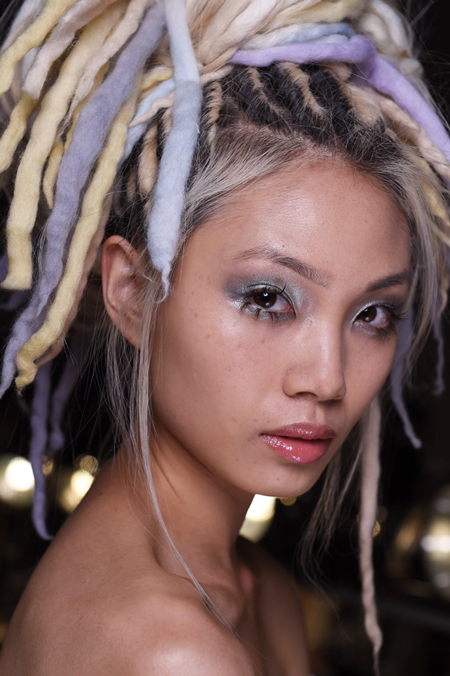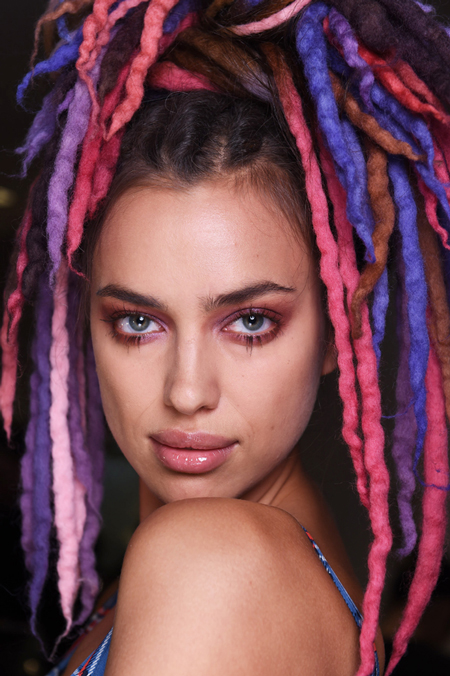The Controversial Rainbow Dreadlocks At Marc Jacobs SS17 & Details On The Makeup Look


The beauty look at the Marc Jacobs Spring 2017 runway show is already stirring up controversy on social media — particularly, the presence of white models sporting rainbow dreadlocks. Some beauty lovers are taking to Twitter and applauding the colorful palette used for both the hair and makeup, noting the nods to rave fashion, Harajuku style, and Rastafarian culture. Others, meanwhile, are accusing Jacobs of cultural appropriation, of not honoring the religious and political beliefs embraced by so many African-Americans and Afro-Latinos who rock dreads.
Jacobs cited Lana Wachowski as the inspiration behind the hair look, which was created by Guido for Redken. For those unacquainted with Lana, she’s an openly transgender woman who was formerly known as Larry Wachowski. She comprises half of The Wachowskis, the filmmaking duo behind The Matrix film trilogy. Her transition from Larry to Lana took place circa 2008, and by 2010, trade publications were already referencing the director by her female name. In 2012, Lana made her first public appearance and, in turn, became a trailblazer for transgender women in Hollywood — after all, she was the first openly transgender director, a responsibility she took seriously as she began advocating for LGBT rights. Lana’s hair is often a Kool Aid shade of red, a hot pink hue, or a deep magenta and she tends to wear purple and pink dreads. As for the connection to Jacobs, Lana was recently featured in a Marc Jacobs ad campaign.
Lana’s decision to wear dreads has provoked quite a few eye rolls, face palms, and irate essays. After all, it was Rastafarians who popularized the dreadlocks hairstyle but, for them, the locks were a celebration of their African heritage and a way to show that they were fighting against imperialism, against racism, against Babylon. To quote Bob Marley, dreads were a way to “emancipate yourself from mental slavery.” But, of course, not everyone who has worn locks has embraced these sociopolitical ideas — for many, including legions of people of color, it’s been just a hairstyle. And yet most people of color are uncomfortable with the sight of white people with locks.
Marc Jacobs surely knew that the decision to send models — primarily white models, at that — down the rainbow sporting wool hair extensions dyed and rolled up to resemble dreads would prove divisive. Maybe that was part of his goal: to start a conversation. After all, he cast Kendall Jenner as one of the models, and we all know the cornrow-loving Kardashian/Jenner clan has been accused of cultural appropriation time and time again. Or maybe Jacobs thought that, since the dreadlocks were rainbow-colored, they would somehow be stripped of their cultural significance and be viewed as whimsical. Maybe he figured it was a way to nod to the extensive history of dreadlocks — from their place in Hinduism (many devout Hindus wear dreads as a sign of their detachment from the material world, their disinterest in manners related to physical appearance and vanity) to their Rastafarian implications, their usage by hippies in the 1960s and onward, their club kid associations (think Boy George int he ’80s and ’90s), and so forth. Fashion is, after all, a medium through which the exchange of ideas and aesthetics can transpire across cultures. But when does it go too far? When does borrowing become stealing? And how can you celebrate a different culture (or a cultural touchstone, if you will) in a respectful manner? These aren’t easy questions to answer. Whether you think dreads should be worn exclusively by people of color or you simply shrug it off as a hairstyle, the issue is a touchy one, and Jacobs certainly hit a raw nerve with this decision.
Which is not to say the look isn’t beautiful or fun. It is. But the issue of cultural appreciation seems to overshadow any discussion of the actual hairstyling work done.
Fortunately, we can discuss the makeup without any such controversy seeping into the conversation! For the look, NARS Cosmetics founder François Nars created six distinct eye looks — silver, purple, pink, green, blue, and copper — each a pastel shade corresponding to the color palette of the hair extensions worn by that particular model. The face was kept very clean, with only minimal makeup applied — mainly the NARSPure Radiant Tinted Moisturizer, Soft Matte Complete Concealer (new for Spring 2017), and Soft Velvet Loose Powder — and lips were bare, save for a layer of clear Triple X Gloss.
The eyes, then, were the focal point of the makeup look. For the silver eye, shown above at top, Nars applied the Lysithia Dual Intensity Eyeshadow and the Interstellar Dual-Intensity Eyeshadow, working the shadows into the upper lid and crease, then bringing the color under the lower lash line, so that it rimmed the entire eye. For the purple look, shown second above, he used the Desdemona Dual-Intensity Eyeshadow and Phoebe Dual-Intensity Eyeshadow. For the green eye, he chose the right side of the Earth Angel Duo Eyeshadow and the Tarvos Dual-Intensity Eyeshadow. For the pink eye, the shadows of choice were the : Desdemona Dual-Intensity Eyeshadow, Phoebe Dual-Intensity Eyeshadow, and the Callisto Dual-Intensity Eyeshadow. For the blue eye, he used the Grande-Large Velvet Shadow Stick and the left side of the Habanero Duo Eyeshadow. And, for the copper look, he relied on the Mediteranee Duo Eyeshadow, Isolde Duo Eyeshadow, and Persia Matte Eyeshadow.
Once the shadows were blended, false lashes were applied to make models’ eyes appear wider and give them greater definition.
The makeup was soft and yet striking, a refreshing way to interpret the minimalism characterizing makeup looks for Spring 2017 , one that doesn’t do away with all color. This part of the beauty look you can most certainly emulate. As for the dreads? I’ll leave that to your own discretion but do consider the weight of your choice.







